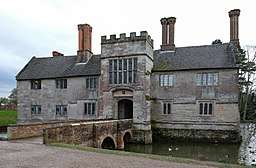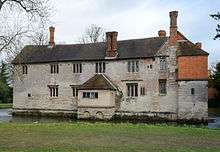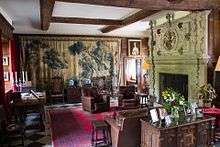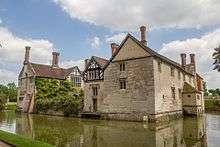Baddesley Clinton
| Baddesley Clinton | |
| stately home | |
 Baddesley Clinton | |
| Country | England |
|---|---|
| State | Warwickshire |
| Region | West Midlands |
| District | Warwick |
| Municipality | Baddesley Clinton |
| Founded | 13th century |
| Owner | National Trust |
| Visitation | accessible to the public with a fee (year round) |
Baddesley Clinton (grid reference SP199714) is a moated manor house, located some 8 miles (13 km) north-west of the historic town of Warwick in the English county of Warwickshire. The house probably originated in the 13th century, when large areas of the Forest of Arden were cleared for farmland. The site is a Scheduled Ancient Monument and the hall a Grade I listed building.[1]
History


In 1438, John Brome, Under-Treasurer of England, bought the manor, which passed to his son, Nicholas. Nicholas was responsible for the extensive rebuilding of the nearby parish church dedicated to St Michael, done as penance for killing the parish priest, a murder reputed to have taken place in the great house itself. The house from this period was equipped with gun-ports, and possibly a drawbridge. When Nicholas Brome died in 1517, the house passed to his daughter, who married Sir Edward Ferrers (High Sheriff of Warwickshire) in 1500. The house remained with the Ferrers family until 1940, when it was purchased by Thomas Walker, a relative of the family who changed his name to Ferrers. His son, who inherited it in 1970, sold the estate in 1980 to the National Trust, which now manages it.
Henry Ferrers "The Antiquary" (1549–1633) made many additions to Baddesley Clinton, including starting the tradition of stained glass representing the family's coat of arms. Such glass now appears in many of the public rooms in the house. It is thought that he was responsible for building the great hall. In the 18th century the great hall was rebuilt in brick, and the east range was extended, though with great care to continue the style of the original building.
The house was inhabited in the 1860s by the novelists Georgiana Chatterton and her second husband Edward Heneage Dering, both of whom converted to Catholicism.[2] The house's Catholic chapel was rebuilt, along with a general refurbishment of the house. Major interior changes took place up until the 1940s, with the first floor outside the chapel being completely altered. The house as it now exists has extensive formal gardens and ponds, with many of the farm buildings dating back to the 18th century. St Michael's church, which shares much history with the house, is a few hundred yards up a lane. Inside the house are a beautiful great hall, parlour and library, amongst other rooms, and there is a great deal of 16th century carving and furniture to be seen, as well as the 19th century accessories the later inhabitants used.
Relationship with Catholicism

The Ferrers appear to have remained Roman Catholic recusants after the Reformation, along with many other members of the Warwickshire gentry. They sheltered Catholic priests, who were under the threat of a death sentence if discovered, and made special provision to hide and protect them. Several priest holes were built, secret passages to hide people in the event of a search. One hole is off the Moat Room, and is simply a small room with a door hidden in the wood panelling. A second leads into the ceiling, and though not visible to visitors, is reputed to hold six people. A third is hidden in an old toilet. Fugitives could slide down a rope from the first floor through the old garderobe shaft into the house's former sewers, which run the length of the building, and could thus probably hold at least a dozen people. These priest holes are said to have been built by Saint Nicholas Owen, a lay-brother of the Jesuits who made many masterful hides, notably at nearby Harvington Hall. He was eventually caught and tortured to death by the Protestant English government.
The hides came into use at least once, in 1591 when a conference of Jesuit priests was raided by local authorities. They did their job, as no-one was caught.[3]
Filming location
In 1986, a number of exterior shots of Baddesley Clinton were used by Granada Television for its Sherlock Holmes series in the episode "The Adventure of the Musgrave Ritual". In October 2016 the house was the venue for BBC One's Antiques Roadshow.[4]
Although described as Baddesley Clinton on the screen, the location used for the outdoor filming of the 1603 raid in the first episode of the 2017 BBC One miniseries Gunpowder about events surrounding the Gunpowder Plot was not actually Baddesley Clinton, but was Fountains Hall near Ripon.[5][6][7][8]
Inspiration for Historical Fiction
Baddesley Clinton was the inspiration for the novel 'My Husband: the Extraordinary History of Nicholas Brome' by Anne Elliott, published in April 2018 by Troubador. The novel explores the turbulent story of C15th lord of the manor, Nicholas Brome, from the perspective of his third wife and widow, Lettice Catesby.
References
- ↑ Historic England. "Baddesley Clinton House and bridge over moat (Grade I) (1035136)". National Heritage List for England. Retrieved 20 August 2014.
- ↑ ODNB entry on Chatterton, Henrietta Georgiana Marcia Lascelles. Retrieved 13 November 2012. Pay-walled.
- ↑ "The raid on Baddesley Clinton remembered". National Trust. Retrieved 30 October 2017.
- ↑ "Baddesley Clinton 1, Series 39, Antiques Roadshow - BBC One". bbc.co.uk. Retrieved 16 October 2016.
- ↑ "Our places in explosive BBC series Gunpowder". National Trust. Retrieved 7 November 2017.
- ↑ Hordley, Chris (20 October 2017). "Where is BBC's Gunpowder filmed?". Creative England. Retrieved 7 November 2017.
- ↑ Laker, Chris (31 October 2017). "Where is Gunpowder filmed?". TV News. BT. Retrieved 7 November 2017.
- ↑ Pickard, Michael (12 October 2017). "Gunpowder, treason and plot". Drama Quarterly. Retrieved 5 November 2017.
Links
- Burke, John. History of the Commoners of Great Britain and Ireland, Volume 3 (1835), pp 127–131; ISBN 978-18472-7168-6
- Warwickshire County Council Timetrail
- The Gatehouse Gazetteer